I've been really having trouble
deciding what engine to put in the car. What I mean is, I know I want a
small block Chevy but I wanted something to set me apart from so many
others out there. What I came up with was a stroked small block. What's
does "stroked" mean?? It's when you put in a crank shaft that
has a longer stroke than the original one has. In this case, the one I
wanted would have a 4.00" stroke rather than a 3.5" like a 350
cubic inch has. Now I know
this doesn't sound like much but add to this a larger diameter bore of
4.155" and we have a larger cubic inch motor. How big you ask, well
after doing the math this will be a 434 cubic inch small block. With this
size motor, it should set me apart from most and I should have plenty
of torque as well. Let's go through some of the components that I will
be using.
|
The block is the foundation for any
engine and the one I will be using is not made by General Motors (GM),
it's made by a company called
Dart. Why didn't I use a GM block?? There
are lots of reasons so let's go through the list. First a
"good" GM block is hard to find and I wanted one that had
four-bolt mains (four bolts on the three center main bearing caps). The
Dart block takes it one step farther by adding the four-bolts to ALL
five main caps. By having all these bolts it adds strength to the whole
assembly which is a good thing. Also, this block has priority main
oiling which means it oils the main bearings first compared to the GM
block that oils the cam bearings first and then the mains. The Dart
block also has thicker material in the critical places, like in the
cylinder bores. Even though I am boring this out to 4.155", there
is still over .250" of wall left. A GM block doesn't even come
close to that.
|
|
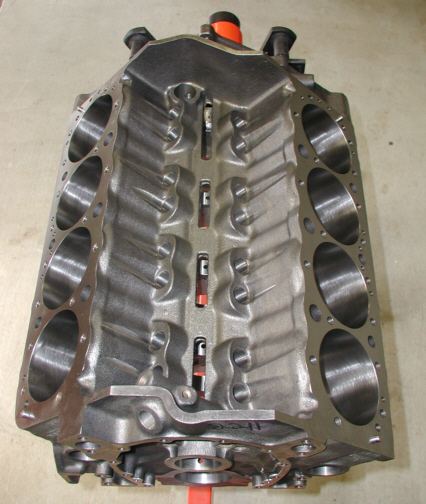
|
Here you can see the bottom of the
block and all five of the main bearing caps with four bolts each.
Another thing this block has it thicker oil pan rails so you can grind
for rod clearance and won't have to worry about hitting water. I'll show
a better picture of what I mean later. Now all this extra material is a
good thing but there's always some bad to go with the good. The bad part
is that it weighs more than a GM block but not by much. The difference
is something like 20 lbs or so. Some of the extra weight has been added
to the web under each main bearing area which is something that has been
a problem with the GM blocks because they are prone to cracking there.
|
|
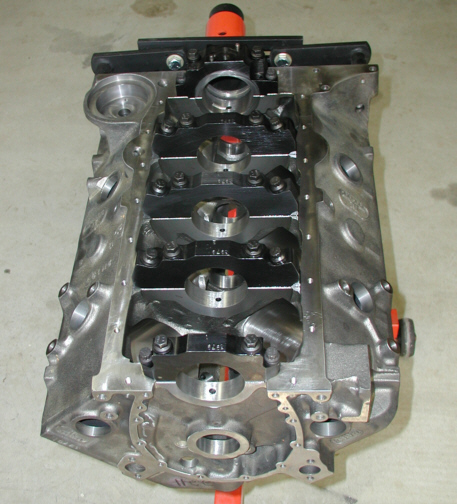
|
This is a shot of how the bores came
out after I got it back from the machine shop. Now these look great and
Dart has instructions on how the block should be bored and honed. When
you get within .003 of final size while honing, your suppose to change to a finer
stone and bring it to size. Then change to a finer one again and
stroke it three times again. One last change to an even finer stone and
then stroke it three more times. After all this the cylinders should be
good to go. One other thing Dart does is blind tap the threaded holes
for the heads. GM's holes go into water so this is another plus.
|
|
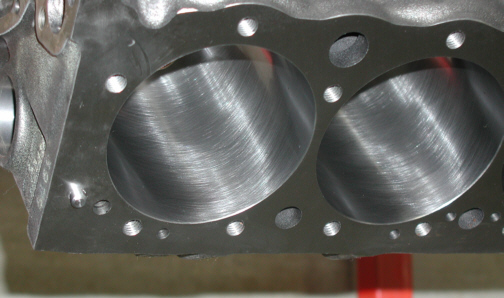
|
This shot is in the valley (middle
when looking down on the top of the block) of the block where the oil
drains back to the oil pan. GM blocks don't have these slots like this
but have holes on each end (one in the front and one in the rear). Well
I like this idea because the oil will have to drain back down right on
the cam. Why is this a good thing? Anytime your idling and engine for
long periods of time with a BIG cam, your asking for trouble because the
cam relies on the splashing effect from the crankshaft to oil the lobs
of the cam. If the RPM of the engine is higher then there's not to much
to worry about. I just see this as some insurance to oil the cam at all
times. Notice the casting flaws in the corners and all through the
slots.
|
|

|
To get as much oil as I can I had to remove all the
flaws so out came the
Dremel for that job. This tool makes fast work when uses with a
1/8" carbide burr.
|
|
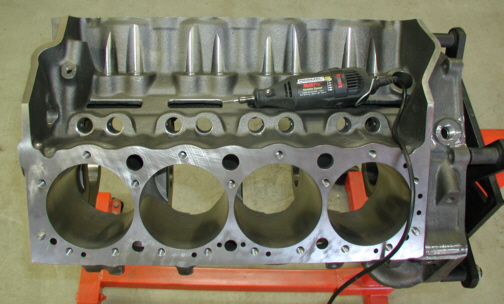
|
Now this looks much better after the
rough edges are all gone and I added a little chamfer around the slots
too. This should drain a little better now.
|
|
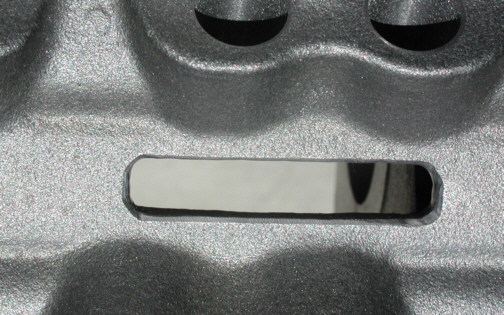
|
|
1 2
3 4
5 6
7 8
9 10
11 12
13 14
15 16
17 18
19 20
21 22
23 24
25
26 27
28 29 |
|
30
31 32
33 34
35 36
37 38 39
40 41
42 43
44 45
46 47
48 49
50 51
52 53
54 55
|
|
56 57
58 59
60 61
62 63 |